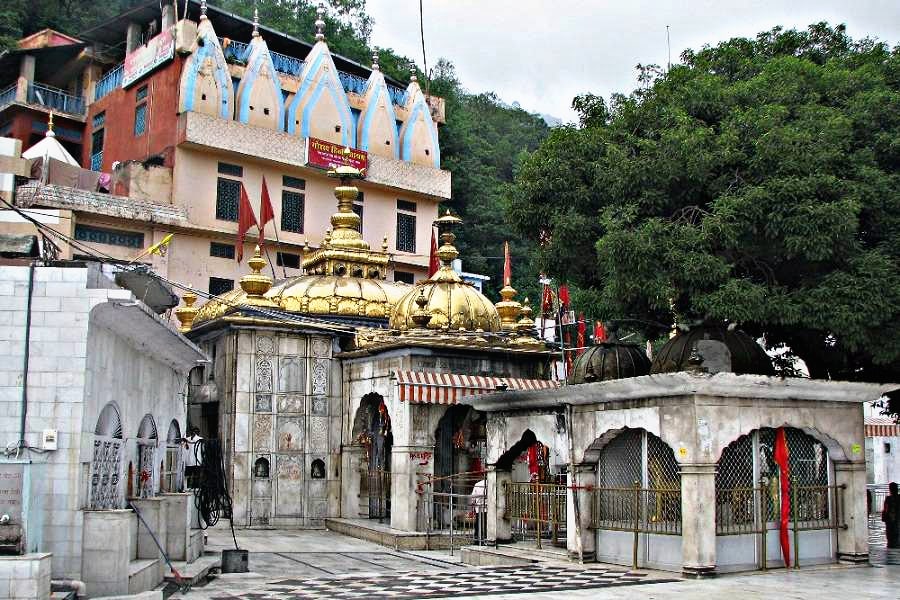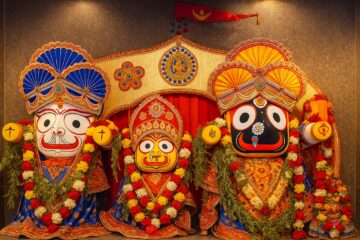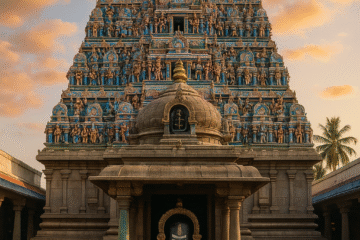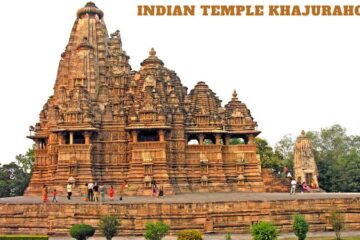
About Jwala Devi Temple in Himachal Pradesh
- Jwala Devi Temple in Himachal Pradesh, also known as Jwala Ji Temple, located in Kangra district of Himachal Pradesh, is one of a kind, there is no idol inside, but there is one flame. The Jwala Devi Temple is dedicated to Jwala Devi (goddess form) who rules in the form of a flame.
- Jwala Devi has no idols and Mata Jwala Devi is worshipped in the form of fires that rise from crevices in the rocks. Raja Bhumi Chand Katoch of Kangra, a great worshiper of Goddess Durga, dreamed of a sacred place, and many rajas wondered where this place was.
- Devi’s sacred flame can be seen in the shrine in nine different ways. The natural flame in the temple is revered as the incarnation of the nine goddesses: Mahakali, Maha Lakshmi, Saraswati, Unpurna, Chandi, Hinglaj, Bindhya Fables, Ambika and Anji Devi.
History of Jwala Devi Temple
- By the grace of Goddess Jwala this place was found and Raja Bhumi Chand Katoch started building the temple. A few years later a flame was discovered in the mountain and Raja Bhumi Chand Katoch built a temple around it and named it Jwala Devi Temple. It is also said that the Pandavas visited this temple and renovated it. The legend says that Akbar, the great Mughal emperor, visited the Jwalamukhi temple to check its originality after Akbar found out about this legend.
- Recognizing the power of Maa Jwala, the goddess of light, Akbar led his army to the temple of Jwala and offered the goddess a golden umbrella, but shortly after offering the dome, the umbrella turned to copper, indicating that the goddess refused his offer.
A Legacy of Flames: Unveiling the Temple's Origins
Legends weave a captivating narrative around the temple’s origin. One popular tale recounts the story of Sati, the consort of Lord Shiva. Upon her self-immolation, Lord Vishnu, seeking to pacify Shiva’s rage, dismembered Sati’s body with his Sudarshana Chakra. It is believed that her tongue fell at the very spot where the Jwala Devi Temple now stands. These eternal flames are seen as a symbolic representation of Sati’s fiery spirit.
Another legend attributes the discovery of the flames to the Pandavas, the heroes of the epic Mahabharata. Guided by a divine dream, they stumbled upon the natural gas fissures and recognized them as a manifestation of the divine.
Historical records suggest that Raja Bhumi Chand, a devout follower of Goddess Durga, dreamt of the sacred flames in the 1st century CE. He embarked on a quest to locate the site and subsequently built a temple around the natural gas fissures. The present structure, however, is attributed to the 19th-century contributions of Maharaja Ranjit Singh and Raja Sansar Chand.
Architectural Grandeur: A Blend of Devotion and Beauty
Jwala Devi Temple in Himachal Pradesh reflects a harmonious blend of architectural styles. The sanctum sanctorum, the holiest part of the temple, houses nine eternal flames, each symbolizing a form of Durga, the powerful aspect of the Divine Mother. These flames, referred to as Jyotis, are named after the Navadurgas – Annapurna, Chandi, Hinglaj, Vindhyavasini, Mahalakshmi, Saraswati, Ambika, Anji Devi, and Maha Kali.
The sanctum sanctorum is built around the natural gas outlets, and the flames lick upwards, appearing to emanate directly from the rock itself. The walls are adorned with intricate carvings and metalwork, reflecting the artistry of bygone eras. A gold-plated dome crowns the temple, shimmering under the sun and symbolizing the divine light emanating from within.
The temple complex also houses various smaller shrines dedicated to other deities like Lord Shiva, Hanuman, and Siddh peeths (seats of accomplished masters). The overall ambience exudes a sense of serenity and devotion, drawing pilgrims from all walks of life.
Rituals and Practices: A Window into Devout Traditions
Visiting the Jwala Devi Temple Himachal Pradesh is a unique and humbling experience. Unlike most Hindu temples, there is no central idol to be worshipped. Devotees offer prayers directly to the flames, presenting offerings like ghee (clarified butter), sweets, and coconuts. Priests, known as pujaris, perform elaborate aartis (fire rituals) with burning lamps, chanting mantras (sacred hymns) that fill the air with a sense of reverence.
An interesting practice at the temple is the absence of bells. The crackling flames are believed to be a form of divine communication, rendering bells unnecessary. Animal sacrifice, once a prevalent practice in some parts of India, is strictly forbidden within the temple complex.
During Navratri, the nine-day festival celebrating the divine feminine, the temple comes alive with vibrant festivities. Special pujas and cultural programs are held, attracting thousands of devotees seeking blessings and participating in the joyous celebrations.
The Enigma of the Flames: Science and Faith Intertwine
The eternal flames of Jwala Devi Temple have captivated minds for centuries. While the source of the natural gas remains a geological mystery, scientific explanations suggest the presence of an underground gas reserve that feeds the flames.
However, for devotees, the Jwala Devi Temple represents a manifestation of the divine. The unwavering nature of the flames, defying all logic and explanation, is seen as a testament to the power of faith and the enduring presence of the Divine Mother.
A Beacon of Hope: Blessings and Significance
Jwala Devi Temple in Himachal Pradesh is a place of immense spiritual significance. Devotees seek blessings for good health, prosperity, and spiritual growth. The temple is also believed to possess the power to grant wishes and ward off evil.
The unwavering flames symbolize the eternal nature of the divine and the ever-burning power of faith. The temple transcends religious boundaries, attracting people from diverse backgrounds who seek solace and spiritual connection.
Beyond the Flames: Exploring the Environs
The Kangra Valley boasts breathtaking natural beauty, with snow-capped mountains, lush green valleys, and cascading waterfalls. The town of Jawalamukhi, where the temple resides, offers a glimpse into the local culture and traditions. Visitors can explore vibrant markets selling regional handicrafts and traditional Himachali cuisine.
For those seeking historical exploration, the Kangra Fort, a magnificent 10th-century structure, stands as a testament to the region’s rich past. Dharamshala, the seat of the Tibetan government-in-exile, is a short distance away and offers a unique cultural experience.
Challenges and Conservation Efforts
The Jwala Devi Temple faces its own set of challenges. The continuous flow of pilgrims can strain the temple’s infrastructure. Maintaining the sanctity of the temple and preserving its heritage requires ongoing efforts.
Conservation efforts focus on managing the flow of devotees and ensuring the temple’s structural integrity. Sustainable practices are being implemented to minimize the environmental impact of the large crowds.
A Legacy Enduring: The Future of Jwala Devi Temple
The Jwala Devi Temple stands as a beacon of faith, attracting devotees for centuries. Its unique blend of myth, history, and spiritual significance ensures its enduring legacy. As conservation efforts continue, the temple is poised to welcome future generations, offering them a glimpse into the timeless power of the divine flames.
In conclusion, the Jwala Devi Temple is more than just a place of worship. It is a cultural and historical landmark that embodies the essence of faith and spirituality. The temple’s enduring legacy lies in its ability to unite people in their reverence for the divine and its commitment to preserving its rich heritage for generations to come.
Jwala Devi Temple FAQs
Q: Where is the Jwala Devi Temple located?
Ans: The Jwala Devi Temple is situated in the Kangra Valley, Himachal Pradesh, India. The temple town of Jawalamukhi is its address.
Q: What is the significance of the Jwala Devi Temple?
Ans: The temple is revered as one of the 51 Shakti Peethas, sacred sites associated with the Goddess Sati. Here, the eternal flames emanating from natural gas fissures are worshipped as a manifestation of the Divine Mother.
Q: What is unique about the temple?
Ans: Unlike most Hindu temples, Jwala Devi enshrines no idol. Devotees offer prayers directly to the nine eternal flames, each representing a form of Durga. Additionally, the absence of bells and the practice of not offering animal sacrifices are unique features.
Q: What are the timings for visiting the temple?
Ans: Timings vary slightly depending on the season. During summers, the temple opens at 5:00 AM and closes at 10:00 PM. Winter timings are from 6:00 AM to 9:00 PM.
Q: What are some important things to remember before visiting the temple?
Ans: Visitors must remove their shoes and wash their hands before entering the temple complex. Dress modestly, covering shoulders and knees. Photography inside the sanctum sanctorum is strictly prohibited.
Q: What are some offerings made at the temple?
Ans: Devotees typically offer ghee (clarified butter), sweets, coconuts, and sometimes gold or silver as a token of gratitude for fulfilled wishes.
Q: When is the best time to visit the temple?
Ans: The temple is open year-round, but the best time to visit weather-wise is from mid-February to mid-June and mid-September to mid-November. However, the temple witnesses large crowds during Navratri, the nine-day festival celebrating Durga.
Q: Are there any other things to see and do near the temple?
Ans: Absolutely! Explore the Kangra Valley’s stunning natural beauty, visit the historic Kangra Fort, or experience the unique Tibetan culture in nearby Dharamshala.
Q: How to reach the Jwala Devi Temple?
Ans: The nearest major airports are in Amritsar and Chandigarh. From there, taxis or buses can take you to Jawalamukhi. Trains connect major cities to nearby stations like Pathankot or Hoshiarpur, from where taxis can take you to the temple.


